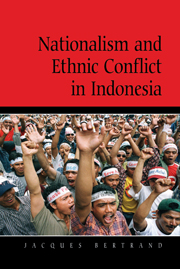Book contents
- Frontmatter
- Contents
- List of figures and tables
- Preface
- Maps
- 1 Introduction
- 2 Critical junctures, nationalism, and ethnic violence
- 3 The national model and its institutional history
- 4 Exclusion, marginality, and the nation
- 5 Islam and nation: The Muslim–Christian dimension
- 6 The escalation of religious conflict
- 7 Conflict in Maluku
- 8 Late integration into the nation: East Timor and Irian Jaya (Papua)
- 9 Aceh's ethnonationalist conflict
- 10 Autonomy as a solution to ethnic conflict
- 11 Unity in diversity
- Notes
- Glossary
- Bibliography
- Index
- CAMBRIDGE ASIA–PACIFIC STUDIES
9 - Aceh's ethnonationalist conflict
Published online by Cambridge University Press: 10 December 2009
- Frontmatter
- Contents
- List of figures and tables
- Preface
- Maps
- 1 Introduction
- 2 Critical junctures, nationalism, and ethnic violence
- 3 The national model and its institutional history
- 4 Exclusion, marginality, and the nation
- 5 Islam and nation: The Muslim–Christian dimension
- 6 The escalation of religious conflict
- 7 Conflict in Maluku
- 8 Late integration into the nation: East Timor and Irian Jaya (Papua)
- 9 Aceh's ethnonationalist conflict
- 10 Autonomy as a solution to ethnic conflict
- 11 Unity in diversity
- Notes
- Glossary
- Bibliography
- Index
- CAMBRIDGE ASIA–PACIFIC STUDIES
Summary
As in Irian Jaya and East Timor under the New Order, the conflict in Aceh took the form of an ethnonationalist struggle against the Indonesian state. When the New Order regime collapsed, the struggle broadened into a civilian movement requesting popular consultation on the future status of Aceh. In parallel to the rise of this civilian movement, the Free Aceh Movement (GAM) intensified its guerilla activities. The type of conflict and the effects of democratization on Acehnese ethnonationalism, therefore, were similar to those in Irian Jaya and East Timor.
Yet, the conflict in Aceh also had striking differences. Whereas East Timor and Irian Jaya shared a history of forced integration into the Indonesian nation, Aceh was always part of the Republic. When nationalist youth organizations organized across the archipelago to fight against the Dutch, the Acehnese joined them. Aceh was one of the regions that contributed financial support to the Indonesian revolution. Even the Darul Islam movement, the first major rebellion of the Acehnese against the Indonesian Republic, did not seek to secede but, instead, to transform the Republic. Regionalist claims and demands for independence came later and did not constitute, as in the case of East Timor and Irian Jaya, a reaction against the means of integration into the Indonesian nation.
The evolution from full participation in the Republic to strong support for secession requires explanation.
- Type
- Chapter
- Information
- Nationalism and Ethnic Conflict in Indonesia , pp. 161 - 183Publisher: Cambridge University PressPrint publication year: 2003



